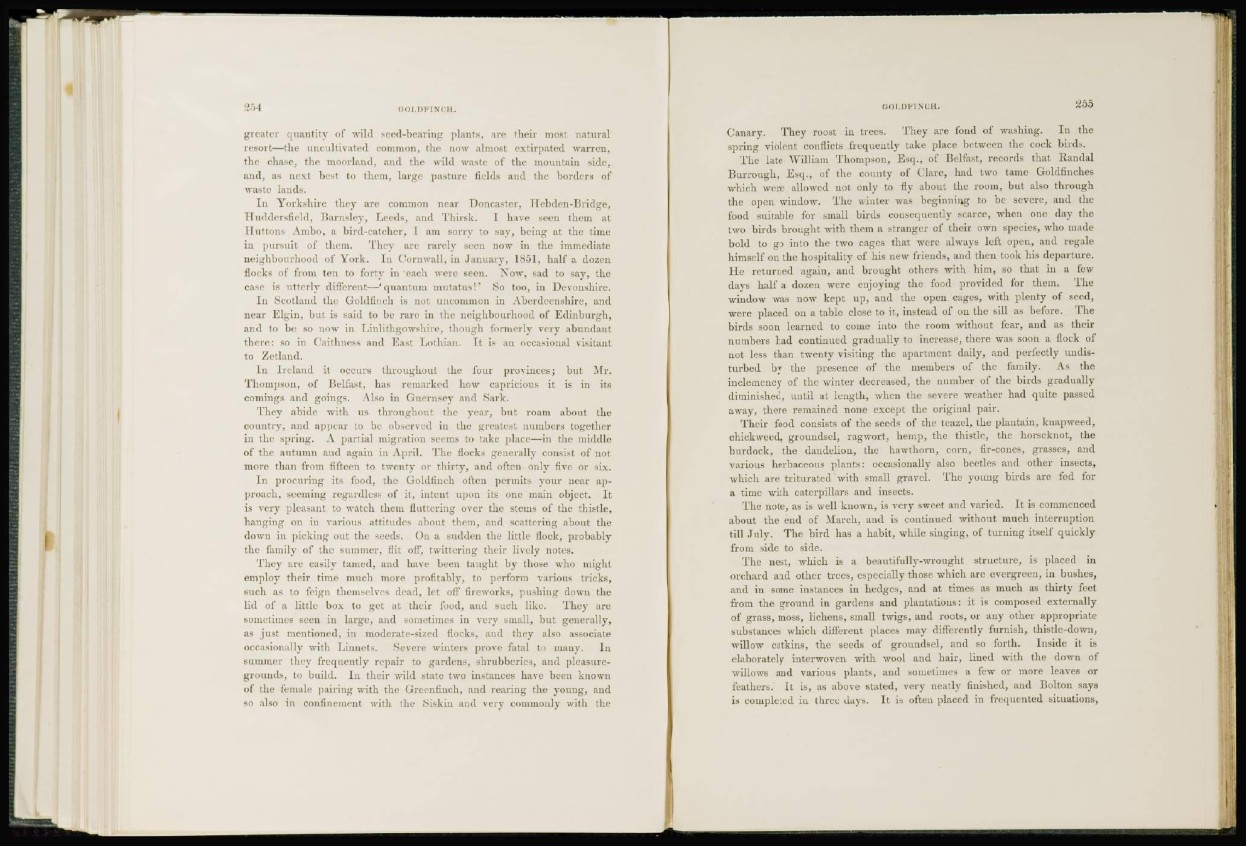
GOLDFINCH.
greater quantity of wild seed-bearing plants, are their most natural
resort—the uncultivated common, the now almost extirpated warren,
the chase, the moorland, and the wild waste of the mountain side,
and, as next best to them, large pasture fields and the borders of
waste lands.
In Yorkshire they are common near Doncaster, Hehdcn-Bridge,
Huddersfield, Barnsley, Leeds, and Thirsk. I have seen them at
Iluttons Ambo, a bird-catcher, 1 am sorry to say, being at the time
in pursuit of them. They arc rarely seen now in the immediate
neighbourhood of York. In Cornwall, in January, 1851, half a dozen
flocks of from ten to forty in each were seen. Now, sad to say, the
case is utterly different—'quantum mutatus!' So too, in Devonshire.
In Scotland the Goldfinch is not uncommon in Aberdeenshire, and
near Elgin, but is said to be rare in the neighbourhood of Edinburgh,
and to be so now in Linlithgowshire, though formerly very abundant
there: so in Caithness and East Lothian. It is an occasional visitant
to Zetland.
In Ireland it occurs throughout the four provinces; but Mr.
Thompson, of Belfast, has remarked how capricious it is in its
comings and goings. Also in Guernsey and Sark.
They abide with us throughout the year, but roam about the
country, and appear to be observed in the greatest numbers together
in the spring-. A partial migration seems to take place—in the middle
of the autumn and again in April. The flocks generally consist of not
more than from fifteen to twenty or thirty, and often only five or six.
In procuring its food, the Goldfinch often permits your near approach,
seeming regardless of it, intent upon its one main object. It
is very pleasant to watch them fluttering over the steins of the thistle,
hanging on in various attitudes about them, and scattering about the
down in picking out the seeds. On a sudden the little flock, probably
the family of the summer, flit off", twittering their lively notes.
They arc easily tamed, and have been taught by those who might
employ their time much more profitably, to perform various tricks,
such as to feign themselves dead, let off fireworks, pushing down the
lid of a little box to get at their food, and such like. They are
sometimes seen in large, and sometimes in very small, but generally,
as just mentioned, in moderate-sized flocks, and they also associate
occasionally with Linnets. Severe winters prove fatal to many. In
summer they frequently repair to gardens, shrubberies, and pleasuregrounds,
to build. In their wild state two instances have been known
of the female pairing with the Greenfinch, and rearing the young, and
so also in confinement with the Siskin and very commonly with the
GOLDFINCH. 255
Canary. They roost in trees. They are fond of washing. In the
spring violent conflicts frequently take place between the cock birds.
The late William Thompson, Esq., of B e l f a s t , records that Randal
Bur rough, Esq., of the county of Clare, had two tame Goldfinches
which were allowed not only to fly about the room, hut also through
the open window. The winter was beginning to be severe, and the
loud suitable for small birds consequently scarce, when one day the
two birds brought with them a stranger of their own species, who made
bold to go into the two cages that were always left open, and regale
himself on the hospitality of his new friends, and then took his departure.
He returned again, and brought others with him, so that in a few
days half a dozen were enjoying the food provided for them. The
window was now kept up, and the open cages, with plenty of seed,
were placed on a table close to it, instead of on the sill as before. The
birds soon learned to come into the room without fear, and as their
numbers had continued gradually to increase, there was soon a flock of
not less than twenty visiting the apartment daily, and perfectly undisturbed
by the presence of the members of the family. As the
inclemency of the winter decreased, the number of the birds gradually
diminished, until at length, when the severe weather had quite passed
away, there remained none except the original pair.
Their food consists of the seeds of the teazel, the plantain, knapweed,
chickwecd, groundsel, ragwort, hem}), the thistle, the horseknot, the
burdock, the dandelion, the hawthorn, corn, fir-cones, grasses, and
various herbaceous plants: occasionally also beetles and other insects,
which are triturated with small gravel. The young birds are fed for
a time with caterpillars and insects.
The note, as is well known, is very sweet and varied. It is commenced
about the end of March, and is continued without much interruption
till July. The bird has a habit, while singing, of turning itself quickly
from side to side.
The nest, which is a beautifully-wrought structure, is placed in
orchard and other trees, especially those which are evergreen, in bushes,
and in some instances in hedges, and at times as much as thirty feet
from the ground in gardens and plantations: it is composed externally
of grass, moss, lichens, small twigs, and roots, or any other appropriate
substances which different places may differently furnish, thistle-down,
willow catkins, the seeds of groundsel, and so forth. Inside it is
elaborately interwoven with wool and hair, lined with the down of
willows and various plants, and sometimes a few or more leaves or
feathers. It is, as above stated, very neatly finished, and Bolton says
is completed in three days. It is often placed in frequented situations,